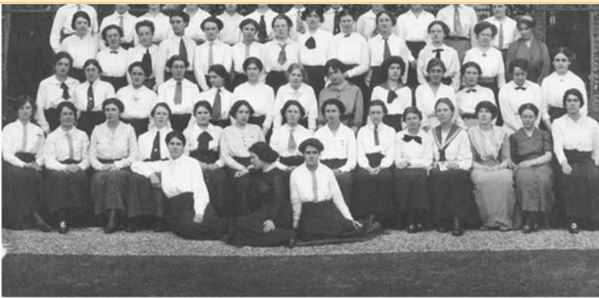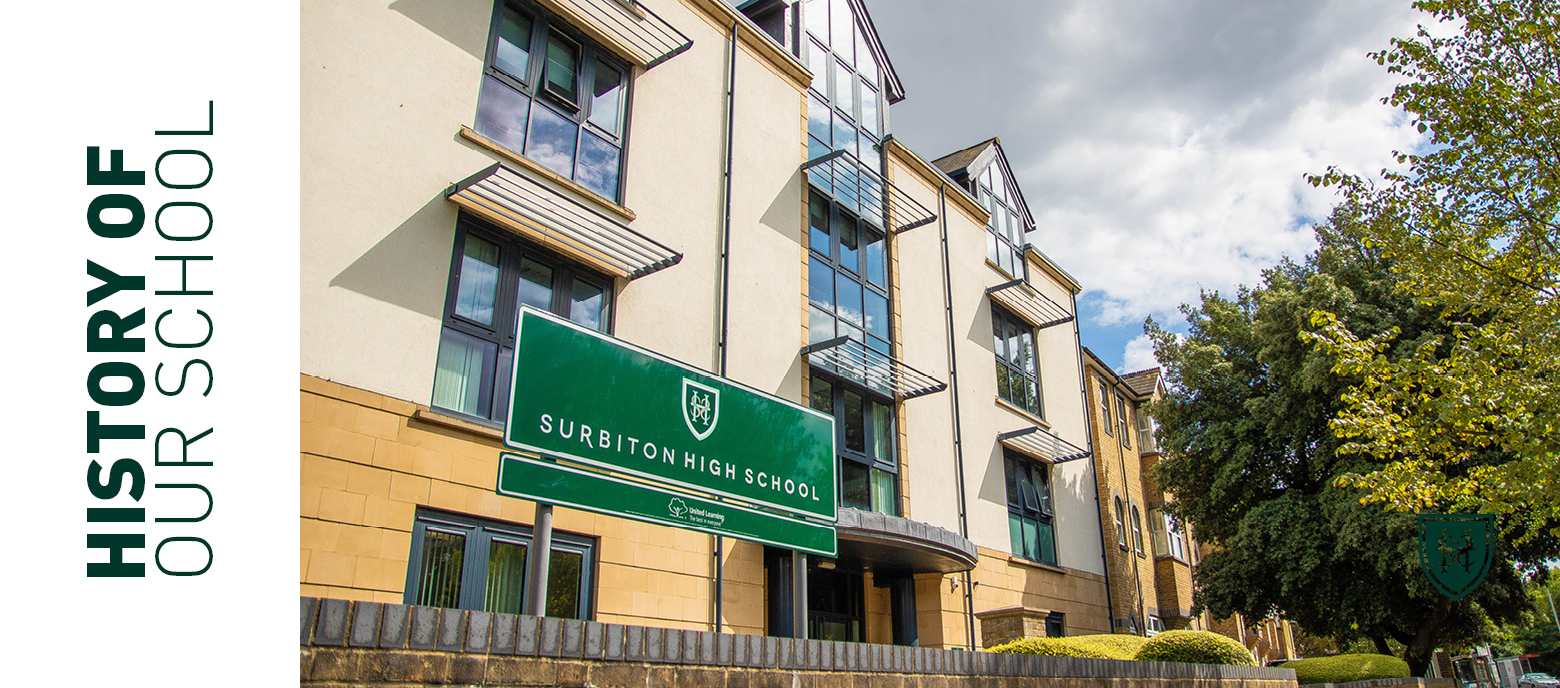
History of Surbiton High School
1899
1899
Dorothy Maud Wrinch (12 September 1894 – 11 February 1976) was a mathematician and biochemical theorist best known for her attempt to deduce protein structure using mathematical principles. She entered Surbiton High School in 1899, at the age of four and a third.
Surbiton High School had been founded 15 years previously, with Miss Alice Maud Procter as the current headmistress.
Remembered today for her much publicized feud with Linus Pauling over the shape of proteins, known as “the cyclol controversy,” Dorothy Wrinch made essential contributions to the fields of Darwinism, probability and statistics, quantum mechanics, x-ray diffraction, and computer science. She was also the first women to receive a doctor of science degree from Oxford University, her understanding of the science of crystals and the ever-changing notion of symmetry has been fundamental to science.
Majorie Senechal, author of Wrinch’s biography, explained that ‘Miss Proctor’s final report on Dorothy was not very encouraging: ‘Well, all I have to say, my dear little Dorothy, is that you will come to a bad end.’ Dorothy was very upset about this – as she explained ‘Proc’s venom and hostility was crucial for me, in that she could withdraw her support, through which alone I could get to Cambridge…. And I wanted to get to Cambridge.’’

But get to Cambridge she did. In autumn 1913, Dorothy Wrinch went up to Girton College, Cambridge. She presented certificates in History, English, Mechanics, French, a paper on Latin, and advanced Mathematics. Senechal explains that ‘‘Proc’ came through for her after all. The Canon of St Marks in Surbiton also vouched for the Wrinch family’s respectability. Eliza Burney, the Archdeacon’s daughter and Miss Procter’s ‘right hand’, was more cautious: “I think Dorothy a little too much inclined to sentimentalism, and naturally sensitive… but she’s a dear girl and thoroughly conscientious – I feel nearly sure that her influence with her companions was to the good.”
1944
1944
Surbiton High School had different house names in 1944: Blue House, Green House, Red House and Yellow House. Students had positions inside the houses: Secretary, Treasurer and Head.
All students helped many charities and collected fruit, vegetables, clothes and food which then were gathered up and were put in sacks for Lambeth ( South London). Due to the fact that in 1944 London was being heavily bombed this charity work so they helped people who were homeless/ in need of food . The Red House put on three short plays to support the charity which raised the bulk of the money.
The Dramatic Society (Or the Drama Club) put on three plays in the Autumn Term. The first was a religious play, (Where love is, God is.)The second a ‘delightful’ comedy,(A Collection Will Be Made) and the third was acomedy about an ordinary family ( The Dear Departed).
Like we go and see plays with school, on October 16th 1944 30 girls were taken (from forms VB to VI) went to Southwark Cathedral to see ‘The Messiah’. After seeing different landmarks, they had lunch in the Vestry and were also given tea, while the Verger gave a short talk about the history of the Cathedral. The party of girls was also given a tour of the Cathedral, with the Verger, who pointed out some interesting Norman and early thirteenth century architecture. Then they were taken to Harvard Chapel and finally the ‘magnificent’ screen and reredos behind the High Altar. Afterwards they saw

A fine performance of the Messiah, given by a full adult choir, a sting orchestra, along with the organ, harpsichord, trumpets and drums. They returned at 6:30 p.m after ‘a very enjoyable day.’ I think it is very interesting that even during war time, the school were able to do such enjoyable school trips. I have highlighted some parts which I think we might still have done today if we were on that school trip.

At 10.15 am on June 3rd (1944) the school attended St. Andrews church (Surbiton) for the Ascension Day service also for the founders day. Like previous years they sung three hymns: ‘Son of God Eternal Saviour’, ‘Our Father by Whose Servants’ and for all the Saints who from theLabours Rest.’ But the Second was actually ‘In our work and in our play.’ They had the same psalm as last year ( No. 121) But it did have a different tune to last year. After the sermon we sang our second hymn, followed by prayers and then the third hymn. The service then closed with a blessing.
By Victoria Penney
Eva Kobrak
Eva Kobrak

Dr. Richard Kobrak was a lawyer after his migration from Breslau, Poland in 1927, the welfare system in the Municipality of Berlin. Dr. Kobrak, his wife Charlotte, née Stern, and his three children, Katherine Toni (born 1918), Helmut Richard (* 1920) and Eva Maria (* 1922), were Christians, but because of their origin were labelled Jews among the racial legislation of the 1935 Nuremberg Laws.
In Berlin, the family lived in the took an active part in community life and from 1935 were members, of the Confessing Church (a Protestant church in Nazi Germany that arose in opposition to government-sponsored efforts to nazify the German Protestant church).
In 1933 Eva’s father, Dr Kobrak, lost his place in the first magistrate. Due to the Nuremberg Laws, as a classified Jew, in 1936 he was forced to take early retirement.
Dr. Kobrak was involved in organising aid for Christians of Jewish origin and directed the 1939-40 Welfare Department in “Office pastor Grueber.”
After Kristallnacht in 1938, the couple sent their three children to England, where the two daughters survived. The son was brought to Australia in 1940, and from there to Bombay. He returned to England in 1952.
The couple were sent to a room in 25 Oak Avenue 25 in Charlottenburg. Dr. Kobrak was made to take part in forced labour at Siemens-Schuckert cable works. In February 1943, Dr. Kobrak and his wife were arrested. They were initially sent to Theresienstadt. Tragically, in October 1944 both Dr and Mrs Kobrak were deported to Auschwitz, where both were murdered.

(Translated from https://www.stolpersteine-berlin.de/en/biografie/1351#slide-0-field_st_bild-1351)
Eva was determined to excel in English. While teaching at Nottingham High School, she went on to take a degree at Bedford College, London. She became head of the English department at Wallington Girls’ School and, in 1964, became headmistress of Surbiton High School. She proved a distinguished headmistress who showed sympathy both for the girls and their parents. She passed on her strong Christian convictions to her pupils and gave the school an ecumenical outlook long before it was fashionable to invite Roman Catholics and Baptists to address an Anglican school.
As well as being headmistress she was a talented artist. She painted landscapes, primarily pictures of Greece and Venice, they mainly seem to be of pastels or possibly watercolours. They were mainly of buildings in Mediterranean countries. Nobody knows were the true inspiration came from for her pictures.
Jane Sutherland remembers Miss Kobrak as headmistress. She says:
‘It is very strange to see these paintings, as I remember she had some on the walls of her office. She was a wonderful person, if a little scary at times. She really encouraged me in my painting and drawing.’
Eva Kobrak died on 23rd June 1982. The History of the School Club would be really interested to hear from any former pupils of Ms Kobrak.
Miss Zoe Procter
Miss Zoe Procter
The sister of the headmistress of Surbiton High School, Zoe Procter, was an admired and influential presence in the school.
In early 1912 Zoe Proctor was inspired by hearing Christabel Pankhurst make an impassioned appeal to volunteer to take part in the 1st March ‘symbolic’ window smashing campaign. Zoe had apparently lost faith with the slowness of the campaign for women’s rights. She signed up.

On March 12th, a fellow suffragette Nina Boyle loaned Zoe a large muff in which she concealed a hammer. She broke a window, was remanded in Holloway Prison and eventually was sentenced to six weeks’ imprisonment.[1] She stood alert in St Martins-in-the-Fields. “I heard the clock strike six… immediately afterwards there sounded the crash of shattered glass from the direction of the Cunard Company’s office, and I hastily turned the corner and swung my hammer against several of the small panes of an old-fashioned silversmith’s shop.”[2]
An uncle hired a lawyer to defend her, but Zoe refused to cooperate and went proudly to jail in Holloway Prison for six weeks. Alice brought her sister baskets of fruit whilst in prison.
Article from the Illustrated London News, 9 March 1912. Entitled ‘Glass-Smashing for Votes! Suffragettes as window-breakers’, the page is printed with illustrations showing suffragettes smashing shop front windows in the West End of London.[3]

[2] Z. Procter, Life and Yesterday, 1960.
[3] From the Museum of London collection.
[4] From the Museum of London collection.


